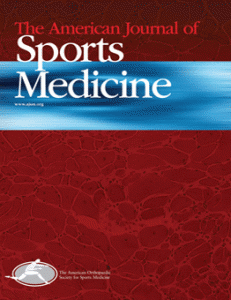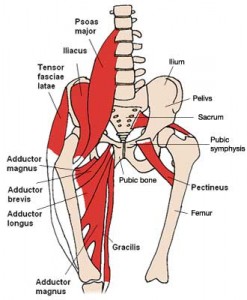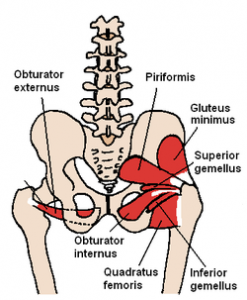Brian Schiff’s Blog
Injury Prevention, Sports Rehab & Performance Training Expert
Eliminating tightness in the TFL can reduce tension in the IT band as well as reduce knee pain associated with Runner’s knee or patellofemoral pain syndrome. Foam rolling prior to stretching is a good idea, but I think this stretch is a good one for all runners to add to their toolbox whether it be prior to or after a run. Check out the stretch from my online PFP column below:
I currently present an on demand and live webinar intended for physical therapists through Allied Health Education (www.alliedhealthed.com) on femoroacetabular impingement (FAI) regarding the recognition of this condition and current treatment principles. Currently, I see on average 3-5 new patients per month with acetabular labral tears and/or those recovering from hip arthroscopy for this issue. As such, I am always staying abreast of the current literature on it.

There is a new research design study that was just published in the August 2014 edition of the Journal of Orthopaedic & Sports Physical Therapy regarding hip pain as it relates to these patients. Specifically, the authors point out that some but not all of the hip pain may be attributed to intra-articular pathology. They suggest that extra-articular contributions from soft tissue (or myofascial pain) may account for hip pain thereby making the diagnosis and assessment of these patients even more complex.
The authors raise some interesting questions about lingering posterolateral hip pain that does not respond to injections or arthroscopy at all. Further, they assert that these patients may have more than one source of hip pain, as well as the possibility that the true source of the pain may not be related to the labrum at all. based on their experience they find that taut and tender gluteal, external rotator and tensor fascia latae (TFL) muscles are present in people with acetabular labral tears who also present with posterolateral hip pain. Previous research has identified myofascial taut bands or nodules as sources of such pain.
It is no secret that running is synonymous with overuse injuries. Despite the best intentions, human nature craves more and more, while the competitive nature in us all to push a little harder also tends to get the best of us at times. One of the most rewarding parts of my job and profession is putting together plans that restore health and maximize performance.

The following story highlights both in an endurance athlete who I had an opportunity to work with last year. Normally I write about research, training and exercise on this blog. This post allows me to share the insight and perspective of one of my clients. I know that many of my readers have battled injuries. I am confident that this story of recovery and learning how to use the RIGHT training will resonate with you.
Click here to read about Anthony’s journey back to running
Let me start off by saying I have the privilege to assess and treat many avid runners on a weekly basis. Some of them are triathletes and others just dedicated runners. While the age and experience level varies, I see more female runners in all.

Recently, a woman in her mid thirties came in for PT after being referred by a physician’s assistant (PA) with a working diagnosis of hip flexor tendinitis. She had developed pain running in the past few weeks. It was now at a level preventing her from running despite using NSAIDS to reduce inflammation.
Specifically, she complained of increased pain with figure 4 sitting, difficulty and pain getting up from a chair, and increased pain with running. Her pain level at the eval was 2/10 but went as high as 9/10 with running. Lots of things can cause pain in the hip joint.

Summary of clinical findings:
- Poor single leg stance on the involved hip with mild pain
- No leg length discrepancy
- Subtle antalgic gait
- AROM for hip and L-spine are within normal limits
- No pain with quad or hip flexor stretching
- Manual muscle testing reveals 5/5 strength for hip flexion (SLR and seated), abduction and adduction
- Pain with FABER testing
- Positive hip impingement sign
- Pain with deep squat
I have been a bit behind on blogging as of late. I try to aim for one per week, but I also strive to deliver sound and relevant content. Additionally, I do not seek outside contributors so finding time to write can be tricky with work and family life too. So, forgive me for any apparent inconsistency in posting. Just know that I will always try to provide valuable content. Today’s post centers around an article in the July 2012 edition of AJSM.

My work at the Athletic Performance Center has provided me an increased opportunity to work with FAI and athletic hip injuries. This is an area of evolution and growth in our field, so I find it particularly interesting to see rationale and thought processes centering around the timing, contribution and selection of hip exercises for active patients/athletes.
This article comes from the Steadman Philippon Research Institute in Vail, CO. The purpose of the study was to measure the highest activation of the piriformis and pectineus muscle during various exercises. The hypothesis was that highest pectineus activation would occur with hip flexion and moderate activity with internal rotation, whereas the highest activation with the piriformis would be with external rotation and/or abduction.


Methods: 10 healthy volunteers completed the following 13 exercises:
- Standing stool hip rotation
- Supine double leg bridge
- Supine single leg bridge
- Supine hip flexion
- Side-lying hip ABD with external rotation
- Side-lying hip ABD with internal rotation
- Side-lying hip ABD against a wall
- Hip clam exercise with hips in 45 degrees of flexion
- Hip clam exercise with hips in neutral
- Prone heel squeeze
- Prone resisted terminal knee extension
- Prone resisted knee flexion
- Prone resisted hip extension
All of these exercises have been reported to be used in hip rehab following arthroscopy or recovery from injury. The exercises were executed slowly and methodically with a metronome to reduce EMG amplitude variations.

